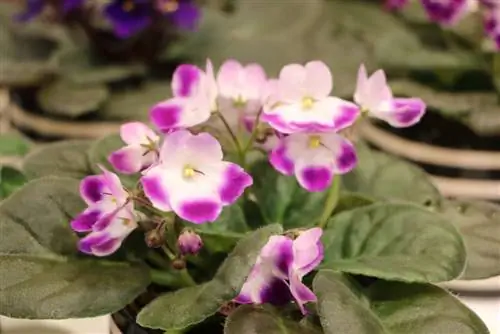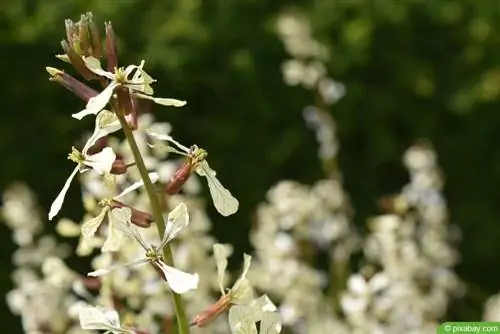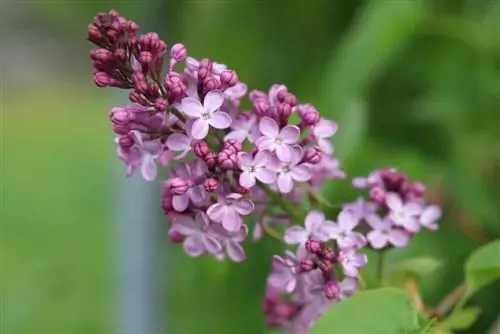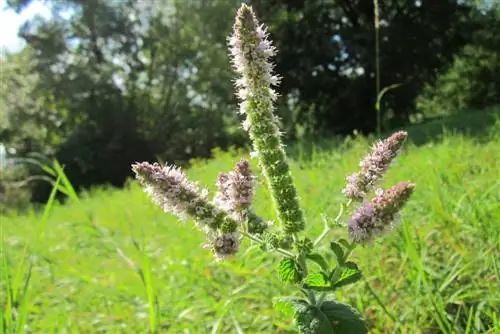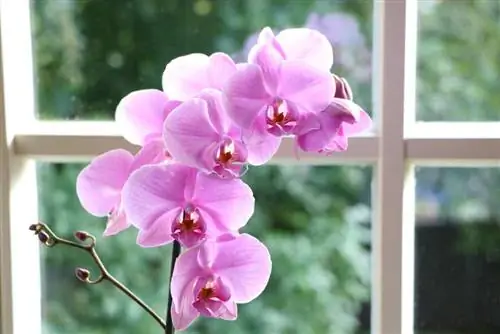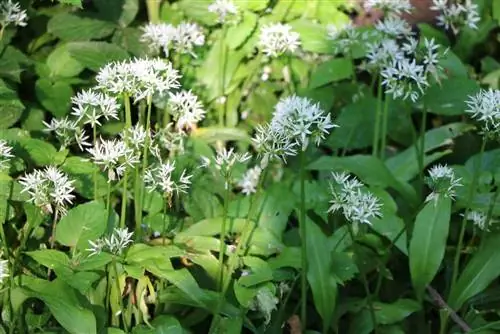- Author admin [email protected].
- Public 2023-12-17 03:39.
- Last modified 2025-01-24 12:45.
The distinctive African violet has made a name for itself as a tireless, continuous bloomer. There is hardly a hobby gardener who does not develop a special soft spot for the delicate houseplant from the tropical regions of East Africa. In general, the pretty Saintpaulia is declared to be easy to care for and pleases the eye with a densely packed abundance of flowers. The circumstance causes even more confusion and annoyance when the African violet does not bloom. Stop wondering about the causes and familiarize yourself with the following tips. How to make it bloom!
Select location
Inappropriate lighting and temperature conditions are often the root of all evil. If there is a deficiency here, all other efforts to achieve lush blooms will be in vain. Therefore, as a first step, subject the site conditions to a precise check. The African violet feels at home here:
- bright to partially shaded location without direct sunlight
- ideally on a west or north window without cold drafts
- Continuously pleasant warmth from 20 to 25 °C
The flowering remains a pious wish if the Saintpaulia is exposed to a cold bridge on the windowsill. This problem arises if there is a continuous connection from the inner to the outer window sill on site. The result is a constantly cold foot that no amount of room temperature, no matter how pleasant, can compensate for. If in doubt, place the plant on an insulating surface that does not allow the root ball to get cold.
Tip:
An African violet's willingness to bloom tends to zero as soon as the room temperature drops below 18 °C. Any care measure should therefore be combined with a careful look at the thermometer.
Maintain humidity
In addition to the temperatures, the optimal site conditions focus on sufficiently high humidity. A spot in the warm, humid bathroom is warmly welcomed by the cute flowering plants and is thanked with a magnificent floral bloom. If you assign them a place in the living room, you can ensure tropical humidity with simple measures:
- set up bowls filled with water
- run an indoor fountain
- Set up an evaporator from a specialist store
- fill the coaster with pebbles and water
Spraying the velvety-soft leaves does not attract any flowers. On the contrary, in this case you will force the formation of rot, which will ultimately cause the entire plant to die.
Substrate with acidic component
In the overall context, the pH value of the substrate occupies a seemingly secondary position. However, if all other conditions are met, this may be exactly where the bottleneck is that sabotages the longed-for flowering of your African violet. The ideal substrate is therefore more of an emotional composition than a simple mixture of ingredients:
- humous, loose potting soil, enriched with a third of peat and some perlite
- optionally TKS1 (peat growing substrate) with a handful of rhododendron soil
- ideally a portion of sifted compost increases the nutrient content
If you decide, for the sake of simplicity, to use clay-containing garden soil as a substrate, which in the worst case is calcareous, you should not be surprised if an African violet does not bloom. In this case, repot the flowering plant in one of the recommended mixtures and look forward to long flowering.
Watering carefully
African violets don't like swings in one direction or the other when it comes to water balance. They cause the tropical plant to bloom if the substrate is constantly moist. Be careful not to allow the root ball to dry out and then completely soak it with water in a panic. In addition, the Saintpaulia will consistently refuse to bloom if it is constantly bothered with cold, lime-containing tap water. Collect rainwater and pour it on the plant at a temperature of around 20°C. Alternatively, fill tap water into the watering can and hang a cotton bag with peat moss in it for 1-2 days. The result is wonderfully soft irrigation water that has at least absorbed the warmth of the surroundings and does not give the plant any cold shock.
Fertilize correctly with a sense of proportion
If an African violet doesn't bloom, it simply doesn't have the energy for this feat. Although a high-quality substrate contributes to the supply of nutrients, it cannot manage this on its own. Give the plant the opportunity to recharge its botanical batteries to get it to bloom.
- Administer a liquid complete fertilizer for flowering plants from March to September
- a 14-day cycle is usually sufficient for nutrient supply
- If particularly lush foliage has developed, weekly application is recommended
- Alternatively, you can use fertilizer sticks according to the manufacturer's dosage instructions
Tip:
The application of fertilizer is not interrupted if an African violet is to bloom all year round under artificial lighting. In this case, energy consumption remains at a constant level.
Take a winter break
Every African violet has the potential to bloom continuously. If it has fulfilled this task reliably in recent years and refuses to bloom again out of the blue, hibernation can work real wonders. To do this, change the site conditions from December to February so that the tropical plant can recover.
- A bright location with cooler temperatures around 15 °C is ideal
- a place by the bedroom window is perfect
- watering reduced when the substrate surface has dried
- do not give fertilizer
As an evergreen gesneria plant, Saintpaulia gathers fresh energy while retaining its leaves. In March, the potted plant moves to its original location, where the recommended care protocol is implemented. Having recovered so well, there is a good chance that the flowers will appear soon afterwards.
Repotting skillfully
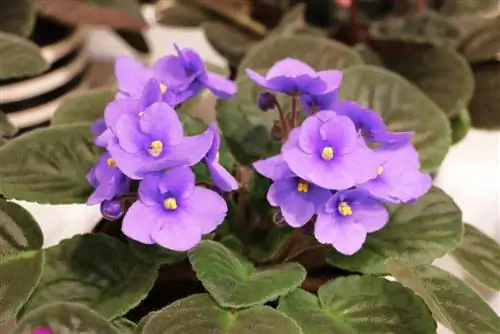
If an African violet feels cramped in its pot, this circumstance noticeably limits its ability to bloom. If root strands grow out of the soil opening while the substrate surface is already bulging, the time is ripe for repotting. The stress of this action is at its lowest level in early spring, shortly before new growth.
- the new flower pot is only slightly larger than the previous vessel
- A water drain in the floor is essential
- Place a piece of pottery over it or pebbles as drainage
- fill in some substrate and plant the potted Saintpaulia in the middle
- ideally the rosette of leaves rests on the edge of the pot
- A small pouring rim of 1-2 cm is useful
Experienced hobby gardeners take this opportunity to subject the root ball to a close inspection. If dried or rotten roots prevent the plant from flowering, they are simply cut out. At the same time, any damaged foliage that could suppress flowering is removed. Leaves that appear unhe althy are torn off to the side with a jerk so that no residue remains on the stem, which gradually rots away.
Diseases & Pests
It cannot be ruled out that an African violet does not bloom because it is affected by a disease or pests. The following he alth problems are more common:
- small leaves
- Aphids, mealybugs, mealybugs
- Spider mites
- Fungal infections
A widespread disease on Saintpaulia occurs as a result of care errors. Mosaic disease causes light green to yellow discoloration on the foliage when the plant is watered with cold water under sunlight. This chlorophyll damage weakens the leaves so massively that they cannot support a flower, so it doesn't even appear.
Conclusion of the editors
If an African violet does not bloom, there are usually solid reasons for this. Instead of throwing in the towel straight away, the busy flowering plant deserves a detailed analysis of the causes in order to resolve the bottleneck. How to make it bloom:
- choose the right location
- Maintain humidity
- Use substrate with acidic component
- pour carefully
- fertilize correctly with a sense of proportion
- take a winter break
- skillfully repotting
If the Saintpaulia does not bloom despite optimal cultivation conditions, the plant is examined for diseases and pests.
What you should know about the African violet in brief
The African violets are named after their homeland, the African mountains in Tanzania. There they grow in the shade of large trees in the rainforests, where the humidity is particularly high. Since they were discovered there in the 19th century, gardeners have continued to breed them so that there are now hundreds of different varieties of these plants in many flower colors. With good care and sufficient light, African violets bloom all year round.
Tips for beautiful flowers
- African violets should be kept bright, but not exposed to direct sunlight and especially not to midday sun. A window sill on a north, east or west window is best, where it is protected from drafts. Because these plants love high humidity, the kitchen and bathroom are particularly recommended.
- Varieties with multi-colored leaves need the brightest possible place so that they retain their leaf pattern. In locations that are too dark, their leaves may turn green.
- African violets require little water. The pot ball should only be kept slightly moist and the top layer of the substrate should be dry before the next watering.
- They should never be poured or sprayed with water on the leaves, otherwise the leaves will easily rot or develop unsightly spots. To prevent the leaves from getting wet, the easiest way is to put the water in a saucer.
- African violets tolerate lime poorly, so it is best to only use rainwater for watering. It should be at room temperature because if the water is too cold the leaves will discolor.
- They thrive best at a temperature of around 20° C and high humidity. In winter they can be kept a little cooler, but the room temperature should still be at least 15° C.
- Repotting the plant is only necessary when the pot ball is completely rooted. Conventional potting soil can be used for this. The new pot should be just a little bigger than the old one so that the plant doesn't put all its energy into root growth and therefore produce fewer flowers.
- In the growing season from spring to autumn, regular fertilization ensures abundant flowering. A liquid fertilizer that is added to the irrigation water or fertilizer sticks with a long-term effect are suitable for this. However, fertilization should not be carried out in the winter months.
- Withered leaves and flowers should not be cut off, but pulled off by hand, otherwise the cut stems will easily begin to rot.
Propagation
African violets are easy to propagate. All you need is a single leaf placed in a container with water or directly in moist potting soil. It quickly forms new roots, creating a new plant. Alternatively, an African violet can also be divided when repotting.

